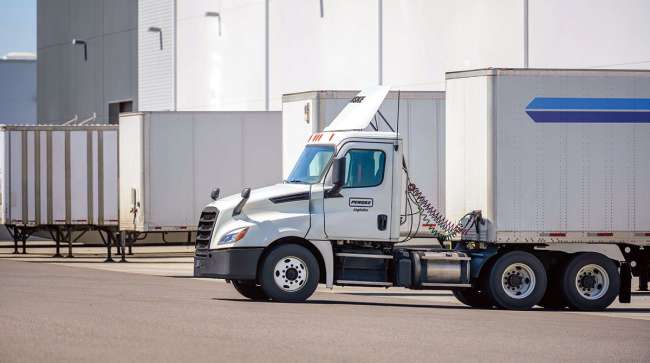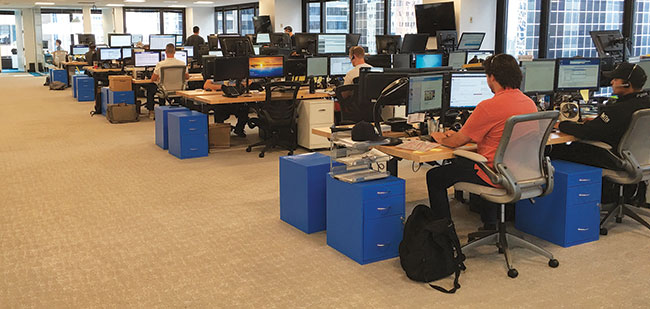Freight Market Volatility Highlights Importance of Broker-Carrier Relationships

[Stay on top of transportation news: Get TTNews in your inbox.]
The freight market volatility of the past few years has created an even greater need for carriers and brokers to strengthen their business relationships, especially as uncertainty and supply chain disruptions persist.
Trusted partnerships between carriers and brokers are particularly important when capacity is tight or shippers need flexibility due to planned or unplanned surges or disruptions.
“Every party is critical to the functioning of the ecosystem. These are very interdependent relationships,” said LeAnne Coulter, vice president of freight management at Penske Logistics.

Nolan
Carriers and brokers alike stand to gain from improved collaboration in the freight market, said Keri Hodnett, PowerBroker product manager at McLeod Software.
“The need for better relationships is equally beneficial to the carrier and the broker regardless of pricing and predictability, but you really draw on those relationships when pricing is uncertain,” she said.
Surging freight demand during the economic recovery from the coronavirus pandemic put a strain on freight capacity, but the U.S. freight market has since loosened.
“For those thousands and thousands of smaller carriers working primarily in the spot market, that means they have less freight to choose from,” said Pat Nolan, vice president of North American surface transportation for C.H. Robinson Worldwide. For those carriers, relationships with brokers are vital when there is less spot freight available, he said.
C.H. Robinson, based in Eden Prairie, Minn., ranks No. 1 on the Transport Topics Top 100 list of the largest logistics companies in North America.
Meanwhile, other factors such as inflation are roiling the freight market.
“We’re not really seeing seasonal surges anymore, but we are seeing more market volatility even outside of the pandemic,” Penske’s Coulter said, adding that the already volatile marketplace is now experiencing increasing fuel and insurance rates.
“You have a lot of expense components impacting carriers,” she said.
Penske Logistics, based in Reading, Pa., ranks No. 21 on the TT100 list of logistics companies.
Market uncertainty is expected to continue for the foreseeable future, so maintaining multiple business channels will be important for many carriers.
“Diversification of sales is the best way to manage your business,” said Andy Dyer, president of transportation management of AFS Logistics, based in Shreveport, La.
Brokerages play a key role in keeping carriers’ wheels moving and helping them operate efficiently, said Kevin Clonch, group director for customer logistics at Ryder System Inc.
“We’ve got to help them eliminate deadhead miles and put them in a position for success,” he said. “We have to help them with the long game.”
Ryder Supply Chain Solutions ranks No. 13 on the TT100 list of logistics companies.
For small- and medium-size carriers, working with brokers also can help reduce back-office expenses.

Carriers looking for freight on C.H. Robinson’s Navisphere platform receive load recommendations based on their preferences, location and fewest deadhead miles.
(C.H. Robinson)
Nolan said small carriers can even run their entire business using C.H. Robinson’s technology — such as its Navisphere Carrier mobile app — to find and book loads, assign drivers, find discounted fuel, upload documents, transmit status updates and get paid.
Industry technology expert and consultant Parker McCrary said the freight brokerage business has been growing.
“When you have volatile market conditions … from a shipper or carrier perspective, that drives freight into the spot market and brokers thrive in a spot market,” he said.
C.H. Robinson, for example, delivered 1 million digital quotes to shippers in the first quarter of this year, a 54% increase from the same period last year.
Plus, the carrier market is highly fragmented. Nolan said nearly 90% of all U.S. carriers have five trucks or fewer, and 66% of them are owner-operators with a single truck. Shippers work with select carriers for only about 20% of their lanes.
“They need about 80% of their lanes covered by brokers, because not all freight is created equal,” Nolan said. “In all those lanes where freight is less dense, less frequent and less predictable, few of the big carriers position trucks there. So, shippers need to tap into the 90% of carriers who have five trucks or less.”
Fostering Business Relationships
Brokerage is a relationship business. Good brokers treat their carrier partners like their shipper customers, industry experts said.
Technology plays an important role in automating day-to-day tasks, which frees sales representatives to focus on those relationships.
“We’re trying to automate the grind and enable brokers to become the broker of choice by only offering loads that matter and then having smart relationship-based conversations when they’re on the phone,” said Dan Cicerchi, vice president of transportation management at logistics software provider Descartes.
The key is knowing which processes to automate.
“Automation is a powerful tool that can be used as an exception management tool, provide tracking and utilize AI on the pricing arena. If brokerages’ end users can obtain frictionless load cycles, your company will have more time to secure new customers, securing future capacity. The broker, shipper and customer can all benefit,” McLeod’s Hodnett said.
Automating the freight matching process can yield increased efficiency and speed.
C.H. Robinson connects carriers directly into enterprise resource planning software and other systems that shippers use to manage their businesses.

C.H. Robinson employees greet the freight broker’s Carrier of the Year award winners at the company’s headquarters. (C.H. Robinson)
“When they need a load covered, our tech knows what trucks are available where at the most competitive rate, and an automated quote from our dynamic pricing engine pops up in their system to book,” Nolan said. “Real-time quotes were a safety net for shippers when trucking capacity was tight and rates were at historic highs. In a softening market, it helps carriers get loads faster and keep their trucks full.”
Descartes’ Cicerchi said it is vital for brokers to align carriers with the right loads for their networks.
Descartes draws on historical and forward-looking data to create a prioritized list of carriers for specific loads. “Secondly, they can automate that whole thing and automatically apply business rules to the system and the system will do outreach on their behalf,” Cicerchi said. “Carriers can add information from their dispatch systems to share their real-time availability. … Speed has become important regardless of capacity.”
Increasing Transparency
McLeod’s Hodnett said companies are increasingly discussing pricing and operational transparency, which can increase trust.
“Being upfront with your carriers with long load times, inconvenient appointment times or route congestion can go a long way to treating your carriers more like a partner and less like a one-and-done,” she said.

In a highly fragmented industry, freight brokers help close the gap between small carriers and shippers to free up more capacity. (Arrive Logistics)
Long-term relationships are founded on — and endure — through trust.
“Trust allows you to rely on decisions you’re making, and you can rely on the other participating party to honor their commitment,” said Dyer, of AFS Logistics.
Carriers, shippers and brokers alike are looking for long-term business relationships because they offer several benefits compared with one-and-done loads.
Ryder’s Clonch said consistency drives the service levels that all parties demand and brokers have to treat carriers like they’re part of the equation.
“If you have a three-legged-stool type of relationship across the board — brokerages, carriers and shippers — they all win,” he said.
Relationships also increase efficiency.
“If I have a person on the floor with great relationships and that person can cover 50 loads with one or two phone calls, we can move more freight at a lower cost of ownership and hopefully pass that cost of ownership on to the customer,” Clonch said.
It costs more time and money to qualify and onboard a carrier with every load.
“In comparison, it costs virtually nothing to leverage an existing carrier partner, not to mention you’ve immediately reduced your risk by using a carrier you already have a relationship with,” Hodnett said, adding that a repeat carrier is more likely to serve the broker in the tight times.
Repeat carriers also reduce uncertainty.
“As you remove unknowns, service and pricing get better and overall the cost gets better,” McCrary said, adding that established carrier-broker relationships enable integrations.
“As you build integrations, you remove the repetitive processes nobody wants to be doing.”
Load integrations from a broker’s transportation management system can help match carriers with loads best suited for them and also speed shipment details by communicating them directly to the carrier and the driver, McCrary said.
Want more news? Listen to today's daily briefing above or go here for more info
What’s more, electronic documentation capture can speed up billing and cash flow.
“You can significantly shrink that money float that is existent out there,” McCrary said.
Technology adoption and business process automation are poised to continue growing in the years ahead.
“We’re starting to take digitization to new levels,” Coulter said. “From a carrier perspective, that type of transformation will aid drivers and carriers and allow them to focus much more of their time on the very necessary activity of transit.”




